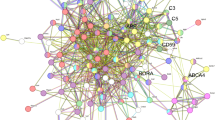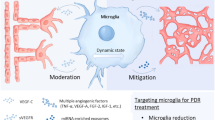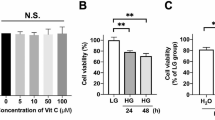Abstract
Retinopathy of prematurity (ROP) is a leading cause of childhood blindness where vascular abnormality and retinal dysfunction are reported. We showed earlier that genetic deletion of aldose reductase (AR), the rate-limiting enzyme in the polyol pathway, reduced the neovascularization through attenuating oxidative stress induction in the mouse oxygen-induced retinopathy (OIR) modeling ROP. In this study, we further investigated the effects of AR deficiency on retinal neurons in the mouse OIR. Seven-day-old wild-type and AR-deficient mice were exposed to 75 % oxygen for 5 days and then returned to room air. Electroretinography was used to assess the neuronal function at postnatal day (P) 30. On P17 and P30, retinal cytoarchitecture was examined by morphometric analysis and immunohistochemistry for calbindin, protein kinase C alpha, calretinin, Tuj1, and glial fibrillary acidic protein. In OIR, attenuated amplitudes and delayed implicit time of a-wave, b-wave, and oscillatory potentials were observed in wild-type mice, but they were not significantly changed in AR-deficient mice. The morphological changes of horizontal, rod bipolar, and amacrine cells were shown in wild-type mice and these changes were partly preserved with AR deficiency. AR deficiency attenuated the Müller cell gliosis induced in OIR. Our observations demonstrated AR deficiency preserved retinal functions in OIR and AR deficiency could partly reduce the extent of retinal neuronal histopathology. These findings suggested a therapeutic potential of AR inhibition in ROP treatment with beneficial effects on the retinal neurons.







Similar content being viewed by others
References
Terry TL (1942) Fibroblastic overgrowth of persistent tunica vasculosa lentis in infants born prematurely: II. Report of cases-clinical aspects. Trans Am Ophthalmol Soc 40:262–284
Good WV, Hardy RJ, Dobson V, Palmer EA, Phelps DL, Quintos M, Tung B (2005) The incidence and course of retinopathy of prematurity: findings from the early treatment for retinopathy of prematurity study. Pediatrics 116:15–23. doi:10.1542/peds.2004-1413
Narayanan SP, Suwanpradid J, Saul A, Xu Z, Still A, Caldwell RW, Caldwell RB (2011) Arginase 2 deletion reduces neuro-glial injury and improves retinal function in a model of retinopathy of prematurity. PLoS ONE 6:e22460. doi:10.1371/journal.pone.0022460
Vessey KA, Wilkinson-Berka JL, Fletcher EL (2011) Characterization of retinal function and glial cell response in a mouse model of oxygen-induced retinopathy. J Comp Neurol 519:506–527. doi:10.1002/cne.22530
Fletcher EL, Downie LE, Hatzopoulos K, Vessey KA, Ward MM, Chow CL, Pianta MJ, Vingrys AJ, Kalloniatis M, Wilkinson-Berka JL (2010) The significance of neuronal and glial cell changes in the rat retina during oxygen-induced retinopathy. Doc Ophthalmol 120:67–86. doi:10.1007/s10633-009-9193-6
O’Connor AR, Stephenson T, Johnson A, Tobin MJ, Moseley MJ, Ratib S, Ng Y, Fielder AR (2002) Long-term ophthalmic outcome of low birth weight children with and without retinopathy of prematurity. Pediatrics 109:12–18
Fulton AB, Hansen RM (1996) Photoreceptor function in infants and children with a history of mild retinopathy of prematurity. J Opt Soc Am A Opt Image Sci Vis 13:566–571
Hansen RM, Harris ME, Moskowitz A, Fulton AB (2010) Deactivation of the rod response in retinopathy of prematurity. Doc Ophthalmol 121:29–35. doi:10.1007/s10633-010-9228-z
Harris ME, Moskowitz A, Fulton AB, Hansen RM (2011) Long-term effects of retinopathy of prematurity (ROP) on rod and rod-driven function. Doc Ophthalmol 122:19–27. doi:10.1007/s10633-010-9251-0
Fulton AB, Hansen RM, Moskowitz A (2009) Development of rod function in term born and former preterm subjects. Optom Vis Sci 86:E653–E658. doi:10.1097/OPX.0b013e3181a6a237
Fulton AB, Hansen RM, Moskowitz A, Barnaby AM (2005) Multifocal ERG in subjects with a history of retinopathy of prematurity. Doc Ophthalmol 111:7–13. doi:10.1007/s10633-005-2621-3
Liang X, Zhou H, Ding Y, Li J, Yang C, Luo Y, Li S, Sun G, Liao X, Min W (2012) TMP prevents retinal neovascularization and imparts neuroprotection in an oxygen-induced retinopathy model. Invest Ophthalmol Vis Sci 53:2157–2169. doi:10.1167/iovs.11-9315
Liu K, Akula JD, Falk C, Hansen RM, Fulton AB (2006) The retinal vasculature and function of the neural retina in a rat model of retinopathy of prematurity. Invest Ophthalmol Vis Sci 47:2639–2647. doi:10.1167/iovs.06-0016
Reynaud X, Hansen RM, Fulton AB (1995) Effect of prior oxygen exposure on the electroretinographic responses of infant rats. Invest Ophthalmol Vis Sci 36:2071–2079
Chen J, Stahl A, Hellstrom A, Smith LE (2011) Current update on retinopathy of prematurity: screening and treatment. Curr Opin Pediatr 23:173–178. doi:10.1097/MOP.0b013e3283423f35
Clark D, Mandal K (2008) Treatment of retinopathy of prematurity. Early Hum Dev 84:95–99. doi:10.1016/j.earlhumdev.2007.11.007
Harder BC, von Baltz S, Jonas JB, Schlichtenbrede FC (2011) Intravitreal bevacizumab for retinopathy of prematurity. J Ocul Pharmacol Ther 27:623–627. doi:10.1089/jop.2011.0060
Davis JM, Auten RL (2010) Maturation of the antioxidant system and the effects on preterm birth. Semin Fetal Neonatal Med 15:191–195. doi:10.1016/j.siny.2010.04.001
Quinn GE, Johnson L, Otis C, Schaffer DB, Bowen FW (1990) Incidence, severity and time course of ROP in a randomized clinical trial of vitamin E prophylaxis. Doc Ophthalmol 74:223–228
Cheung AK, Lo AC, So KF, Chung SS, Chung SK (2007) Gene deletion and pharmacological inhibition of aldose reductase protect against retinal ischemic injury. Exp Eye Res 85:608–616. doi:10.1016/j.exer.2007.07.013
Chung SS, Ho EC, Lam KS, Chung SK (2003) Contribution of polyol pathway to diabetes-induced oxidative stress. J Am Soc Nephrol 14:S233–S236
Lee AY, Chung SS (1999) Contributions of polyol pathway to oxidative stress in diabetic cataract. FASEB J 13:23–30
Lou MF, Dickerson JE Jr, Garadi R, York BM Jr (1988) Glutathione depletion in the lens of galactosemic and diabetic rats. Exp Eye Res 46:517–530
Obrosova IG (2005) Increased sorbitol pathway activity generates oxidative stress in tissue sites for diabetic complications. Antioxid Redox Signal 7:1543–1552. doi:10.1089/ars.2005.7.1543
Obrosova IG, Pacher P, Szabo C, Zsengeller Z, Hirooka H, Stevens MJ, Yorek MA (2005) Aldose reductase inhibition counteracts oxidative-nitrosative stress and poly(ADP-ribose) polymerase activation in tissue sites for diabetes complications. Diabetes 54:234–242
Song Z, Fu DT, Chan YS, Leung S, Chung SS, Chung SK (2003) Transgenic mice overexpressing aldose reductase in Schwann cells show more severe nerve conduction velocity deficit and oxidative stress under hyperglycemic stress. Mol Cell Neurosci 23:638–647
Fu ZJ, Li SY, Kociok N, Wong D, Chung SK, Lo AC (2012) Aldose reductase deficiency reduced vascular changes in neonatal mouse retina in oxygen-induced retinopathy. Invest Ophthalmol Vis Sci 53:5698–5712. doi:10.1167/iovs.12-10122
Ho HT, Chung SK, Law JW, Ko BC, Tam SC, Brooks HL, Knepper MA, Chung SS (2000) Aldose reductase-deficient mice develop nephrogenic diabetes insipidus. Mol Cell Biol 20:5840–5846
Smith LE, Wesolowski E, McLellan A, Kostyk SK, D’Amato R, Sullivan R, D’Amore PA (1994) Oxygen-induced retinopathy in the mouse. Invest Ophthalmol Vis Sci 35:101–111
Connor KM, Krah NM, Dennison RJ, Aderman CM, Chen J, Guerin KI, Sapieha P, Stahl A, Willett KL, Smith LE (2009) Quantification of oxygen-induced retinopathy in the mouse: a model of vessel loss, vessel regrowth and pathological angiogenesis. Nat Protoc 4:1565–1573. doi:10.1038/nprot.2009.187
Akula JD, Mocko JA, Moskowitz A, Hansen RM, Fulton AB (2007) The oscillatory potentials of the dark-adapted electroretinogram in retinopathy of prematurity. Invest Ophthalmol Vis Sci 48:5788–5797. doi:10.1167/iovs.07-0881
Li SY, Yang D, Fu ZJ, Woo T, Wong D, Lo AC (2012) Lutein enhances survival and reduces neuronal damage in a mouse model of ischemic stroke. Neurobiol Dis 45:624–632. doi:10.1016/j.nbd.2011.10.008
Yang D, Li SY, Yeung CM, Chang RC, So KF, Wong D, Lo AC (2012) Lycium barbarum extracts protect the brain from blood–brain barrier disruption and cerebral edema in experimental stroke. PLoS ONE 7, e33596. doi:10.1371/journal.pone.0033596
Haverkamp S, Wassle H (2000) Immunocytochemical analysis of the mouse retina. J Comp Neurol 424:1–23
Li SY, Fu ZJ, Ma H, Jang WC, So KF, Wong D, Lo AC (2009) Effect of lutein on retinal neurons and oxidative stress in a model of acute retinal ischemia/reperfusion. Invest Ophthalmol Vis Sci 50:836–843. doi:10.1167/iovs.08-2310
Morrow EM, Chen CM, Cepko CL (2008) Temporal order of bipolar cell genesis in the neural retina. Neural Dev 3:2. doi:10.1186/1749-8104-3-2
Robinson GA, Madison RD (2004) Axotomized mouse retinal ganglion cells containing melanopsin show enhanced survival, but not enhanced axon regrowth into a peripheral nerve graft. Vis Res 44:2667–2674. doi:10.1016/j.visres.2004.06.010
Watanabe M, Rutishauser U, Silver J (1991) Formation of the retinal ganglion cell and optic fiber layers. J Neurobiol 22:85–96. doi:10.1002/neu.480220109
Pekny M, Nilsson M (2005) Astrocyte activation and reactive gliosis. Glia 50:427–434. doi:10.1002/glia.20207
Miller RF, Dowling JE (1970) Intracellular responses of the Muller (glial) cells of mudpuppy retina: their relation to b-wave of the electroretinogram. J Neurophysiol 33:323–341
Nakamura S, Imai S, Ogishima H, Tsuruma K, Shimazawa M, Hara H (2012) Morphological and functional changes in the retina after chronic oxygen-induced retinopathy. PLoS ONE 7:e32167. doi:10.1371/journal.pone.0032167
Dal Monte M, Latina V, Cupisti E, Bagnoli P (2012) Protective role of somatostatin receptor 2 against retinal degeneration in response to hypoxia. Naunyn Schmiedeberg’s Arch Pharmacol 385:481–494. doi:10.1007/s00210-012-0735-1
Wachtmeister L (1998) Oscillatory potentials in the retina: what do they reveal. Prog Retin Eye Res 17:485–521
Mowat FM, Gonzalez F, Luhmann UF, Lange CA, Duran Y, Smith AJ, Maxwell PH, Ali RR, Bainbridge JW (2012) Endogenous erythropoietin protects neuroretinal function in ischemic retinopathy. Am J Pathol 180:1726–1739. doi:10.1016/j.ajpath.2011.12.033
Fulton AB, Reynaud X, Hansen RM, Lemere CA, Parker C, Williams TP (1999) Rod photoreceptors in infant rats with a history of oxygen exposure. Invest Ophthalmol Vis Sci 40:168–174
Dembinska O, Rojas LM, Varma DR, Chemtob S, Lachapelle P (2001) Graded contribution of retinal maturation to the development of oxygen-induced retinopathy in rats. Invest Ophthalmol Vis Sci 42:1111–1118
Olney JW (1968) An electron microscopic study of synapse formation, receptor outer segment development, and other aspects of developing mouse retina. Invest Ophthalmol 7:250–268
Bai Y, Ma JX, Guo J, Wang J, Zhu M, Chen Y, Le YZ (2009) Müller cell-derived VEGF is a significant contributor to retinal neovascularization. J Pathol 219:446–454. doi:10.1002/path.2611
Dorrell MI, Aguilar E, Jacobson R, Trauger SA, Friedlander J, Siuzdak G, Friedlander M (2010) Maintaining retinal astrocytes normalizes revascularization and prevents vascular pathology associated with oxygen-induced retinopathy. Glia 58:43–54. doi:10.1002/glia.20900
Bringmann A, Pannicke T, Grosche J, Francke M, Wiedemann P, Skatchkov SN, Osborne NN, Reichenbach A (2006) Müller cells in the healthy and diseased retina. Prog Retin Eye Res 25:397–424. doi:10.1016/j.preteyeres.2006.05.003
Bringmann A, Iandiev I, Pannicke T, Wurm A, Hollborn M, Wiedemann P, Osborne NN, Reichenbach A (2009) Cellular signaling and factors involved in Müller cell gliosis: neuroprotective and detrimental effects. Prog Retin Eye Res 28:423–451. doi:10.1016/j.preteyeres.2009.07.001
Al-Shabrawey M, Bartoli M, El-Remessy AB, Platt DH, Matragoon S, Behzadian MA, Caldwell RW, Caldwell RB (2005) Inhibition of NAD(P)H oxidase activity blocks vascular endothelial growth factor overexpression and neovascularization during ischemic retinopathy. Am J Pathol 167:599–607. doi:10.1016/S0002-9440(10)63001-5
Lo AC, Cheung AK, Hung VK, Yeung CM, He QY, Chiu JF, Chung SS, Chung SK (2007) Deletion of aldose reductase leads to protection against cerebral ischemic injury. J Cereb Blood Flow Metab 27:1496–1509. doi:10.1038/sj.jcbfm.9600452
Penn JS, Tolman BL, Bullard LE (1997) Effect of a water-soluble vitamin E analog, trolox C, on retinal vascular development in an animal model of retinopathy of prematurity. Free Radic Biol Med 22:977–984
He T, Xing YQ, Zhao XH, Ai M (2007) Interaction between iNOS and COX-2 in hypoxia-induced retinal neovascularization in mice. Arch Med Res 38:807–815. doi:10.1016/j.arcmed.2007.05.003
Coombs JL, Van Der List D, Chalupa LM (2007) Morphological properties of mouse retinal ganglion cells during postnatal development. J Comp Neurol 503:803–814. doi:10.1002/cne.21429
Shao Z, Fu Z, Stahl A, Joyal JS, Hatton C, Juan A, Hurst C, Evans L, Cui Z, Pei D, Gong Y, Xu D, Tian K, Bogardus H, Edin ML, Lih F, Sapieha P, Chen J, Panigrahy D, Hellstrom A, Zeldin DC, Smith LE (2014) Cytochrome P450 2C8 omega3-long-chain polyunsaturated fatty acid metabolites increase mouse retinal pathologic neovascularization–brief report. Arterioscler Thromb Vasc Biol 34:581–586. doi:10.1161/ATVBAHA.113.302927
Fu Z, Lofqvist CA, Shao Z, Sun Y, Joyal JS, Hurst CG, Cui RZ, Evans LP, Tian K, SanGiovanni JP, Chen J, Ley D, Pupp IH, Hellstrom A, Smith LE (2015) Dietary ω-3 polyunsaturated fatty acids decrease retinal neovascularization by adipose–endoplasmic reticulum stress reduction to increase adiponectin. Am J Clin Nutr 101(4):879–888. doi:10.3945/ajcn.114.099291
Li J, Liu CH, Sun Y, Gong Y, Fu Z, Evans LP, Tian KT, Juan AM, Hurst CG, Mammoto A, Chen J (2014) Endothelial TWIST1 promotes pathological ocular angiogenesis. Invest Ophthalmol Vis Sci 55:8267–8277. doi:10.1167/iovs.14-15623
Wang Z, Cheng R, Lee K, Tyagi P, Ding L, Kompella UB, Chen J, Xu X, Ma JX (2015) Nanoparticle-mediated expression of a wnt pathway inhibitor ameliorates ocular neovascularization. Arterioscler Thromb Vasc Biol 35:855–864. doi:10.1161/ATVBAHA.114.304627
Wang Z, Moran E, Ding L, Cheng R, Xu X, Ma JX (2014) PPARalpha regulates mobilization and homing of endothelial progenitor cells through the HIF-1alpha/SDF-1 pathway. Invest Ophthalmol Vis Sci 55:3820–3832. doi:10.1167/iovs.13-13396
Acknowledgments
This study is supported by the Seed Funding Programme for Basic Research from The University of Hong Kong as well as the Germany/Hong Kong Joint Research Scheme 2009/2010 (RGC Project No.: G HK029/09).
Conflict of interests
All authors certify that they have NO affiliations with or involvement in any organization or entity with any financial interest (such as honoraria; educational grants; participation in speakers1 bureaus; membership, employment, consultancies, stock ownership, or other equity interest; and expert testimony or patent-licensing arrangements), or non-financial interest (such as personal or professional relationships, affiliations, knowledge or beliefs) in the subject matter or materials discussed in this manuscript.
Author information
Authors and Affiliations
Corresponding author
Additional information
Zhongjie Fu and Shen Nian contributed equally to this work.
Electronic supplementary material
Below is the link to the electronic supplementary material.
Online Resource 1
In RA and OIR, the amplitudes of a-wave, b-wave, and OPs at low and high light intensity for both genotypes. RA, room air; OIR, oxygen-induced retinopathy. (DOCX 16 kb)
Online Resource 2
In RA and OIR, the implicit time of a-wave, b-wave, and OPs at low and high light intensity for both genotypes. RA, room air; OIR, oxygen-induced retinopathy. (DOCX 16 kb)
Online Resource 3
The ONL, INL, and IPL thickness in central and mid-peripheral retinal areas on P17 and P30. ONL, outer nuclear layer; INL, inner nuclear layer; IPL, inner plexiform layer. (DOCX 18 kb)
Rights and permissions
About this article
Cite this article
Fu, Z., Nian, S., Li, SY. et al. Deficiency of aldose reductase attenuates inner retinal neuronal changes in a mouse model of retinopathy of prematurity. Graefes Arch Clin Exp Ophthalmol 253, 1503–1513 (2015). https://doi.org/10.1007/s00417-015-3024-0
Received:
Revised:
Accepted:
Published:
Issue Date:
DOI: https://doi.org/10.1007/s00417-015-3024-0




